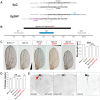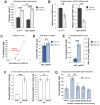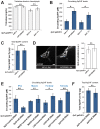A genetic strategy to measure circulating Drosophila insulin reveals genes regulating insulin production and secretion
- PMID: 25101872
- PMCID: PMC4125106
- DOI: 10.1371/journal.pgen.1004555
A genetic strategy to measure circulating Drosophila insulin reveals genes regulating insulin production and secretion
Abstract
Insulin is a major regulator of metabolism in metazoans, including the fruit fly Drosophila melanogaster. Genome-wide association studies (GWAS) suggest a genetic basis for reductions of both insulin sensitivity and insulin secretion, phenotypes commonly observed in humans with type 2 diabetes mellitus (T2DM). To identify molecular functions of genes linked to T2DM risk, we developed a genetic tool to measure insulin-like peptide 2 (Ilp2) levels in Drosophila, a model organism with superb experimental genetics. Our system permitted sensitive quantification of circulating Ilp2, including measures of Ilp2 dynamics during fasting and re-feeding, and demonstration of adaptive Ilp2 secretion in response to insulin receptor haploinsufficiency. Tissue specific dissection of this reduced insulin signaling phenotype revealed a critical role for insulin signaling in specific peripheral tissues. Knockdown of the Drosophila orthologues of human T2DM risk genes, including GLIS3 and BCL11A, revealed roles of these Drosophila genes in Ilp2 production or secretion. Discovery of Drosophila mechanisms and regulators controlling in vivo insulin dynamics should accelerate functional dissection of diabetes genetics.
Conflict of interest statement
The authors have declared that no competing interests exist.
Figures




References
-
- Imamura M, Maeda S (2011) Genetics of type 2 diabetes: the GWAS era and future perspectives. Endocr J 58: 723–739. - PubMed
-
- Rulifson EJ, Kim SK, Nusse R (2002) Ablation of insulin-producing neurons in flies: growth and diabetic phenotypes. Science 296: 1118–1120. - PubMed
-
- Ikeya T, Galic M, Belawat P, Nairz K, Hafen E (2002) Nutrient-dependent expression of insulin-like peptides from neuroendocrine cells in the CNS contributes to growth regulation in Drosophila. Curr Biol 12: 1293–1300. - PubMed
Publication types
MeSH terms
Substances
Grants and funding
LinkOut - more resources
Full Text Sources
Other Literature Sources
Medical
Molecular Biology Databases

